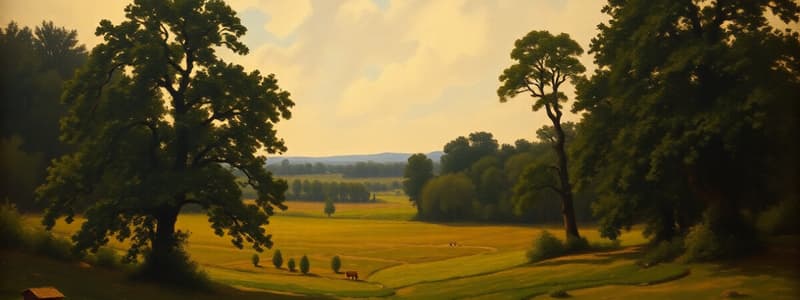Podcast
Questions and Answers
What is the primary legal fiction regarding land ownership in the context of the manorial system?
What is the primary legal fiction regarding land ownership in the context of the manorial system?
- Tenants have full ownership rights over their land.
- Land is granted by the Crown and held beneficially. (correct)
- Only free tenants can hold land from the Crown.
- Individuals own land outright.
Which group of tenants is most common in the manorial system?
Which group of tenants is most common in the manorial system?
- Tenants who have sold their rights to land.
- Free tenants with full rights.
- High-ranking nobles owning land independently.
- Unfree tenants bound to the landlord. (correct)
What marked the emergence of the system of registration in the manorial court process?
What marked the emergence of the system of registration in the manorial court process?
- The creation of common law for free tenants.
- The lord's consent to a deed of sale. (correct)
- A tenant's desire to alienate land.
- The establishment of a court jury.
What was the main impact of the feudal system on land tenure?
What was the main impact of the feudal system on land tenure?
In the context of the manorial land system, what role did unfree tenants serve?
In the context of the manorial land system, what role did unfree tenants serve?
What type of land ownership provides the closest form to absolute ownership in modern property law?
What type of land ownership provides the closest form to absolute ownership in modern property law?
Which of the following correctly describes the crown's relationship to unallocated land?
Which of the following correctly describes the crown's relationship to unallocated land?
Which historical framework significantly influenced the modern understanding of land tenure?
Which historical framework significantly influenced the modern understanding of land tenure?
In English property law, what is the primary distinction between 'imperium' and 'dominium'?
In English property law, what is the primary distinction between 'imperium' and 'dominium'?
Which of the following types of land tenure signifies a right linked to the Crown?
Which of the following types of land tenure signifies a right linked to the Crown?
Why was the distinction between inalienable and alienable land significant in historical property law?
Why was the distinction between inalienable and alienable land significant in historical property law?
Which estate type is considered to have lesser rights and is primarily an interest in land?
Which estate type is considered to have lesser rights and is primarily an interest in land?
How did the married women's property act of 1882 influence fee tails?
How did the married women's property act of 1882 influence fee tails?
What best describes freehold ownership in modern property law?
What best describes freehold ownership in modern property law?
Which of the following is NOT a characteristic of leasehold ownership?
Which of the following is NOT a characteristic of leasehold ownership?
What is the primary purpose of the feudal system in land distribution?
What is the primary purpose of the feudal system in land distribution?
How does an estate in land law differentiate between freehold and leasehold?
How does an estate in land law differentiate between freehold and leasehold?
What is a fee simple estate?
What is a fee simple estate?
What role does equity serve in regards to property rights?
What role does equity serve in regards to property rights?
What does the concept of 'tail' or entail in estate law signify?
What does the concept of 'tail' or entail in estate law signify?
What structural arrangement does leasehold ownership often involve?
What structural arrangement does leasehold ownership often involve?
Flashcards
Manorial Land System
Manorial Land System
A system of land ownership in medieval England. Landlords (lords of the manor) held control and tenants (free or unfree) had obligations to them. Unfree tenants were essentially attached to the land and could be asked for service at any time.
Unfree Tenants
Unfree Tenants
Tenants in a manorial system who were not entirely free to leave the land and were obligated to provide service to the lord.
Free Tenants
Free Tenants
Tenants with more freedom and rights than unfree tenants in the manorial system. They had specific obligations outlined.
Manorial Court
Manorial Court
Signup and view all the flashcards
Copyhold Tenure
Copyhold Tenure
Signup and view all the flashcards
Fee Simple
Fee Simple
Signup and view all the flashcards
Fee Tail
Fee Tail
Signup and view all the flashcards
Life Estate
Life Estate
Signup and view all the flashcards
Crown's Ownership
Crown's Ownership
Signup and view all the flashcards
Public vs. Private (Land)
Public vs. Private (Land)
Signup and view all the flashcards
Freehold Tenure
Freehold Tenure
Signup and view all the flashcards
Leasehold Tenure
Leasehold Tenure
Signup and view all the flashcards
Feudal System
Feudal System
Signup and view all the flashcards
Freehold Ownership
Freehold Ownership
Signup and view all the flashcards
Leasehold Ownership
Leasehold Ownership
Signup and view all the flashcards
Estate in Land
Estate in Land
Signup and view all the flashcards
Fee Simple Estate
Fee Simple Estate
Signup and view all the flashcards
Socage Tenure
Socage Tenure
Signup and view all the flashcards
Equity in Property Rights
Equity in Property Rights
Signup and view all the flashcards
Medieval Land Grants
Medieval Land Grants
Signup and view all the flashcards
Concept of Sub-Grants
Concept of Sub-Grants
Signup and view all the flashcards
Study Notes
Synopsis of Tenure and Estates
- English land law is built on the doctrines of tenure and estates.
- Tenure describes the medieval relationship between the monarch and landholders. Estates represent the different bundles of rights and powers related to that land.
- Tenure involved a landholder transferring ownership to a feudal lord or monarch in exchange for rights to possess and profit from the land.
- Tenants were protected from interference, similar to a vicarious liability (vassal).
- The doctrine of tenure meant the monarch had ultimate title to all land.
- The doctrine of estates clarified tenant ownership, distinguishing it from the land itself and defining estates of varying lengths. Multiple people could hold interests simultaneously on the same land.
- John Locke and Thomas Hobbes were significant legal thinkers, marking a shift from divine kings to individual reason and social contracts.
- Property was used as a platform to understand how societies evolve.
- Tenure describes the relationship between tenant and superior (the crown); the crown has absolute dominion over the land through tenure.
Norman Invasion of 1066
- Series of invasions weakened the English state.
- Commendation emerged: powerful individuals offered protection to less powerful neighbors, creating a lord-vassal relationship.
- Landholding was hierarchical: crown, lords, tenants.
Feudal Structure
- By 1086, a large portion of land was held by the king, church, and the king's followers (1500).
- Feudal structure ended by the 14th century.
Tenure Forms
- Occupational: Linked to occupation (knights, serjeanty, frank-almoign, socage).
- Socage: Non-military, non-clerical obligations (e.g., paying rent, performing public duty).
- Serjeanty: More formal service (e.g., holding important offices).
Commendation Practices (Forms)
- Homage: acknowledgment of subordinate status.
- Oath of fealty: ritual process acknowledging obligations to the feudal lord.
- Investiture: transferring land ownership.
Doctrine of Estates
- Tenants owned an estate in land, not the land itself.
- Estates differed in duration, allowing multiple interests in the same land.
- This concept differentiates between land ownership and the use of the land.
Simultaneous Interests in Land
- Successive interests in land coexist.
- Freeholder has the right to create lesser interests (e.g., leaseholds).
- Simultaneous estates and interests require clarity.
Seisin
- The crucial link between a person and land.
Estates of Freehold
- Fee simple: Closest to absolute ownership.
- Fee tail: Limited inheritance to specific heirs.
- Life estate: Ownership for a tenant's lifetime.
Crown's Land Ownership
- The crown holds land in two senses: exercised or held directly.
- The crown holds ultimate ownership of all land.
Public and Private Land Ownership
- The distinction between public and private land ownership is paradoxical.
- The monarch held dominium over inalienable property, and the state held dominium over alienable land.
Legal and Equitable Rights
- Equitable ownership emerged from legal inconsistencies.
- Equitable rights are protected from those with knowledge of the right.
Medieval Land Ownership
- The crown (monarch) was the ultimate owner of all land.
- Land was granted to individuals (tenants) in exchange for services.
- This system created a hierarchical structure (king, lords, tenants).
- The system was characterized by multiple layers of obligations and relationships.
The Concept Of Tenure
- Land ownership in English law is defined by a relational concept—tenure..
- Two major types of tenure are freehold and leasehold.
- Freehold ownership signifies non-leasehold land with no specific obligations.
- Leasehold ownership grants land use for a defined period.
The Concept Of Estate
- An estate in land refers to the duration that land is held in ownership.
- It differentiates between freehold and leasehold estates.
- Freehold estates include fee simple (highest form of ownership), and fee tail; leasehold estates are defined by term in which land is held.
The Influence Of Feudal System
- The feudal system's influence on English laws persists; landowners hold their land in relation to the crown.
- Statutory reforms converted services to monetary payments in the 17th-19th century..
Studying That Suits You
Use AI to generate personalized quizzes and flashcards to suit your learning preferences.




